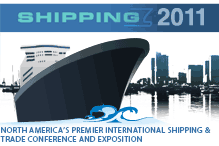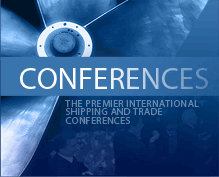
Fast Ship or Fast Talk?
It is my experience that the shipping industry is notoriously opinionated and, true to form, everyone seems to have an opinion about fast ocean cargo. Usually a negative one.
At a recent shipping convention cocktail party, I had the opportunity to ask a technical guy what he thought of fast ocean cargo and he immediately started drawing graphs with his martini glass, slopping steep lines of gin through the air representing fuel costs on the one hand and exponentially increasing resistance on the other. I asked a mariner and he shook his head wisely and regaled me with tales of unholy waves out there beyond the cozy confines of the button-down office and the testing tank. A certain freight market analyst went on about market segments and pricing gaps until the ice in my drink melted. Finally, when asked for his opinion, a shipping CEO neatly gave me a combination of all of the above with a self confident roll of the eyes meant to convey that the idea of fast cargo didn’t keep him awake at night.
Given the abundance of all of the informed, negative opinions, will there ever be a successful fast ocean cargo service? In my opinion, the answer is yes.
Continue Reading
THE SHORT ESCAPE TO THE CAPE: A Project Profile
by Geoff. Uttmark
A curious aspect of shipping is the continental size of the separation between “the market”, gossiped about by everyone, and niche opportunities, discussed by no one outside the family or group and its closest allies. No one actually lives the homogenized BIFFEX. Everyone aspires to beat it, or its equivalent, whatever the sector, whatever it takes. The nature of intense near-perfect competition is that even an individual ship’s location can be privileged information, potentially more relevant to fixing at an acceptable rate than the broader market forces. Secrecy may be warranted, but it has the effect of also preserving shipping’s notorious insularity and nepotism. Ships change hands – but usually between worthy adversaries who have known (of) each other for years. New companies are formed – but often out of old ones. Developing countries nurture enterprises within their borders – but run afoul of the traditional maritime nations when they try to extend the “infant industry” argument to maritime. Factor in shipping’s barriers to entry in the form of capital intensiveness and seemingly chronic low financial returns and small wonder that entrepreneurial ambitions that might inject some needed creativity rarely leave the dock.
Continue Reading
Atoning for the Albatrosses
by Geoff. Uttmark
Creating an infrastructure isn’t easy, even in an environment as fluid as water. It is expensive, tedious and high risk. In light of what now seems obvious about what works and doesn’t to stimulate and sustain the renaissance of privately operated ferry services in the US, some of the early false steps can claim more than their share of sardonic humor. It’s as if this embryonic industry managed to shoot down every albatross that flew its way. The course, of course, was eventually discovered and diligently followed. But before we climb the mast to see what’s over the horizon, a look astern can provide some appreciation of what has been achieved, and what might be, someday. We learn from our own mistakes; we laugh from those of others. And there have been plenty. A sampling:
“Meet Aquarama”: An early promoter of intra-Great Lakes excursions probably regretted his choice of words when his ship met the dock once too often. This connector of communities achieved monumental community disconnect and was awarded the nickname “Aquarammer” that decidedly did not translate to ridership loyalty. The consolation prize for demise of this enterprise was that a ready market for scrap steel existed in Indiana where Aquarama made her last port. Continue Reading
Freshly Minted – August 26, 1999
OSG
Overseas Shipholding Group has completed a $170 million financing related to its U.S. flag Alaskan tanker fleet. The financing represents a securitization of the receivables arising from the charters of five of its U.S. flag crude vessels to Alaska Tanker Company, the entity which manages the vessels carrying BP Amoco P.L.C.’s Alaskan crude oil. The financing, which has a seven-year final maturity and was priced 40 bps over LIBOR. American Marine Advisors arranged the transaction and placed the debt, which was taken by National Australia Bank.
HIGH YIELD
All Quiet on the high yield front. At these levels, everyone that wanted to buy has bought them and everyone that still has bonds has them for a reason. Just how slow are things in shipping high yield? Keith Stephenson, shipping high yield analyst at Jefferies, has picked up coverage on metals and mining and movie theaters. That’s how slow. Going around the dial:
NAVIGATOR GAS
No fresh news about Cryofin and its quest to own a controlling stake in Navigator Gas Transport, though we do understand that Bjorn Q. and Nunzio LePomi have resigned their positions at NavGas Management. Speculation exists that Aaserod has divested his interest in Navigator and it is presently unknown whether such a sale represents a violation of the shareholders agreement. Bjorn’s previous attempt to sell his position to Phoenix was never concluded and we understand that Phoenix is pursuing legal action against Mr. Aaserod. Credit Suisse issued research on Navigator and recommended that investors Hold. Continue Reading
Freshly Minted – August 19, 1999
GOT GAS?
“Natural Gas is widely expected to be the fastest growing primary energy source in the world over the next 25 years.” Energy Information Administration says.
In the November issue of Marine Money, we will publish analysis of the LNG Market, the implications for shipping, the world fleet and order book and a whole lot more about what we think is an exciting area of maritime project finance.
BJORN PASSES (NAV)GAS
Bjorn Q. Aaserod appears to have sold his stake in Navigator Gas Transport to Cryofin Group of Italy, which through its ownership of Artic Gas was a fellow shareholder in Navigator Gas Transport. Cryofin maintains that it has entered into an agreement with Jiangian Shipyard in China to build 5 more ethylene carriers and claim to have 90% finance for 12 years from the Chinese export bank. Cryofin hopes to corner the market for LPG/Ethylene/Chemical markets. The shares which will ostensibly go to Artic were the same shares that were supposedly sold to Phoenix several months ago.
HIGH YIELD Continue Reading
Freshly Minted – August 12, 1999
We begin this week with some news from Marine Money Headquarters:
JIM TURNS 45
We would like to wish a Happy 45th Birthday to our founding father Jim Lawrence.
MARINE MONEY OPENS LONDON OFFICE
Newly appointed Marine Money Publisher Nicolai Heidenreich will be moving to London tomorrow, on lucky Friday the 13th, to open a new office for Marine Money. His contact information is below:
Marine Money International
320 Old Brompton Road
London SW5 9JH
United Kingdom
Phone/Fax: + 44 (0) 207 259 2246
Mobile: + 44 (0) 774 701 4376
E-mail: nheidenreich@marinemoney.com
FINANCING FERRIES Continue Reading
Freshly Minted – August 5, 1999
Well, we wish all of you that are not in your offices doing business that we can write about a very “happy” vacation. At least tell us before you go so we can get your mobile numbers and can pester you at your summerhouses. Not fair.
What else is there to expect of August, except slumbering heat at least in the New York area and water restrictions depriving us of showers and personal hygiene.
The results of the Summer Raffle are in and we have a winner. No it was not Mr. De Moulin, nor Mr. Aaserod who was the shagedelic swinger. It was Mr. Tung. Who would have thought. Only two people out of 85 responses had the correct answer. We tossed the two correct entries in a hat and the lucky winner was……(drum roll, please)
SCROLL DOWN TO BOTTOM OF FRESHLY MINTED
HIGH YIELD Continue Reading
Equity – August 1999
Equity – August 1999 Continue Reading
Swan Reefer Debt Restructuring
You got to know when to hold em,
Know when to fold em,
Know when to walk away,
Know when to run…
Aage Figenschou, managing director of Oslo-listed Swan Reefer, knows all that, and also when to smile. He could well afford to on June 1, after MeesPierson and ING agreed a restructuring of $243m in total mortgage debts. The figure was a remnant of two tranches, a senior one worth $220m (both banks) and a junior one of $30m (ING) raised in the summer of 1998 in connection with the ambitious $164.5m takeover of Irgens Larsen’s shipping operations. The banks were concerned about the loans due to Swan’s low liquidity, a dead reefer market, and low vessel values. They had declared Swan to be in default, and had given the company until June 1 to work out a recapitalisation and restructuring, or else. The “or else”, of course, was liquidation.
Continue Reading
Maintaining Shareholder Value in a Company that has Reached Critical Mass
by Bjørn Møller, Teekay Shipping Corporation
The topic of my discussion is “maintaining shareholder value in a company that has reached critical mass”. To address this topic, we need to clarify what it is shareholders want. This is not intended to educate you in something you probably understand as well as I do, but the answer forms the backdrop for my comments.
Ultimately, what all shareholders want is maximization of their share price. For this to happen requires the creation of Shareholder Value. As the company’s management, everything we do should be for the long term interest of our shareholders, with the ultimate aim of raising that stock price.
However, there is an important distinction to be made between the priorities of shareholders in private companies and of those in public companies.
Continue Reading







